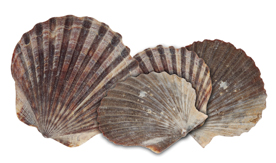Spotlight on Giant Sea Scallops

A University of Maine doctoral student hopes her appearance in a comedy clip on the late-night satirical The Colbert Report will shed light on the serious topic of fishery management.
Skylar Bayer, a doctor of philosophy student in marine biology at the Darling Marine Center in Walpole, Maine, studies the reproductive ecology of giant sea scallops, Placopecten magellanicus.
Her goal is to glean information that will contribute to best fishery management practices and thereby support the next generation of scallops and the next generation of scallop fishermen.
The giant sea scallop, says Bayer, represents a lucrative commercial fishery on the East Coast. Three years ago, due to overfishing, the Department of Marine Resources closed 20 percent of Maine’s coastal waters to rebuild the population. Some of those areas are now reopening.
Giant sea scallops are broadcast spawners, she says, meaning males and females release gametes into the water column, where sperm fertilize eggs and larvae develop.
Bayer is researching whether local environmental conditions such as currents and temperature, as well as the timing of the release of eggs and sperm, impact the proportion of eggs that get fertilized and, in turn become larvae. She’s also experimenting to determine whether shrinking population densities of scallops dilutes gametes and decreases the chances that sperm will come into contact with and fertilize eggs.
Sea scallop reproduction, says Bayer, is no laughing matter. Tell that to Stephen Colbert.
In the 7:16 clip titled “The Enemy Within” that aired March 4 on the Emmy and Peabody Award-winning show, Bayer was jokingly described as “a lonely lady scientist” collecting scallop reproductive organs, perhaps with the evil intent to create Scallop Man.
“My parents are huge fans of The Colbert Report,” Bayer says, explaining one reason why she accepted the offer to be on the show. “It does a particularly good job of promoting science with humor and in a backwards way.”
Plus, she says, the mishap that drew the attention of Colbert field producer Nicole Savini was benign and silly. While it served the show’s over-the-top style well, Bayer says the topic wasn’t controversial and wouldn’t likely alienate academic or fisheries contacts.
The clip reenacted a Nov. 26, 2012 incident when scallop diver Andy Mays was supposed to meet Bayer at a Somesville convenience store and give her sea scallop gonads for her research.
He mistakenly placed a covered bucket of scallop gonads intended for Bayer into another University of Maine vehicle parked at the convenience store.
Gail Garthwait, an associate professor in the College of Education, was driving the vehicle in question. She was buying a snack in the store when Mays put the samples in the back seat; she discovered the formaldehyde-labeled bucket later that day.
Thanks to Mays’ wife, Michelle calling local police and the Bangor Daily News, and the subsequent explosion of the “missing scallop guts” on social media, the mystery was solved in a couple days.
Bayer wrote about the incident in a blog she edits — strictlyfishwrap — and The Colbert Report took notice.
The Massachusetts native says the feedback she’s received about the clip, much of it from the scientific community, has been resoundingly positive.
She says she’s grateful the clip included viewer-friendly information about her research. Bayer says she’s wanted to join the Darling Marine Center (DMC) since she read Trevor Carson’s The Secret Life of Lobsters when she was a teenager. UMaine researchers Bob Steneck, Rick Wahle and Lewis Incze were three real-life characters in the book.
At DMC, Bayer likes the mix of academia and interaction with local fishermen, including Mays. “They are a wealth of knowledge,” she says of those who earn their livelihood on the water.
In the wake of her appearance, Bayer is continuing her experiments and is applying for funding to continue her research.
Perhaps Colbert was angling to have something related to sea scallops named in his honor. He reportedly already has a couple of scientific namesakes — Stelephant Colbert, an elephant seal that’s part of a University of California Santa Cruz study; and Agaporomorphus colberti, a Venezuelan diving beetle.
Contact: Beth Staples, 207.581.3777
